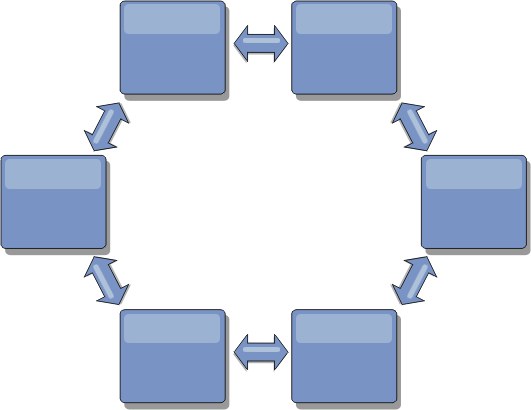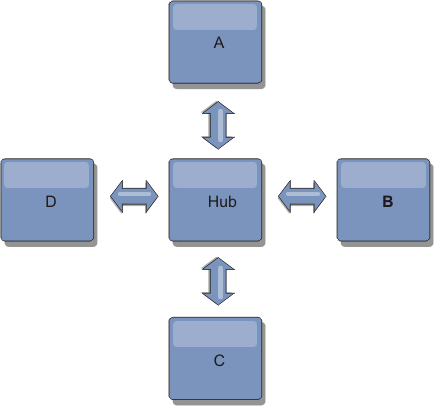Design considerations for multi-master replication
When implementing multi-master replication, you must consider aspects in your design such as: arbitration, linking, and performance.
Arbitration considerations in topology design
- Default collision arbiter: The default protocol is to use the changes from the lexically lowest named catalog service domain. For example, if catalog service domain A and B generate a conflict for a record, then the change from catalog service domain B is ignored. Catalog service domain A keeps its version and the record in catalog service domain B is changed to match the record from catalog service domain A. This behavior applies as well for applications where users or sessions are normally bound or have affinity with one of the data grids.
- Custom collision arbiter: Applications can provide a custom arbiter. When a catalog service domain detects a collision, it starts the arbiter. For information about developing a useful custom arbiter, see Developing custom arbiters for multi-master replication.
- Multiple catalog service domains experience a collision
- Each catalog service domain handles the collision locally, producing revisions
- The revisions collide, resulting in revisions of revisions
To avoid collisions, choose a specific catalog service domain, called an arbitration catalog service domain as the collision arbiter for a subset of catalog service domains. For example, a hub-and-spoke topology might use the hub as the collision handler. The spoke collision handler ignores any collisions that are detected by the spoke catalog service domains. The hub catalog service domain creates revisions, preventing unexpected collision revisions. The catalog service domain that is assigned to handle collisions must link to all of the domains for which it is responsible for handling collisions. In a tree topology, any internal parent domains handle collisions for their immediate children. In contrast, if you use a ring topology, you cannot designate one catalog service domain in the ring as the arbiter.
| Topology | Application Arbitration? | Notes |
|---|---|---|
| A line of two catalog service domains | Yes | Choose one catalog service domain as the arbiter. |
| A line of three catalog service domains | Yes | The middle catalog service domain must be the arbiter. Think of the middle catalog service domain as the hub in a simple hub-and-spoke topology. |
| A line of more than three catalog service domains | No | Application arbitration is not supported. |
| A hub with N spokes | Yes | Hub with links to all spokes must be the arbitration catalog service domain. |
| A ring of N catalog service domains | No | Application arbitration is not supported. |
| An acyclic, directed tree (n-ary tree) | Yes | All root nodes must rate their direct descendants only. |
Linking considerations in topology design
- Change latency
Change latency is determined by the number of intermediate catalog service domains a change must go through before arriving at a specific catalog service domain.
A topology has the best change latency when it eliminates intermediate catalog service domains by linking every catalog service domain to every other catalog service domain. However, a catalog service domain must perform replication work in proportion to its number of links. For large topologies, the sheer number of links to be defined can cause an administrative burden.
The speed at which a change is copied to other catalog service domains depends on additional factors, such as:- Processor and network bandwidth on the source catalog service domain
- The number of intermediate catalog service domains and links between the source and target catalog service domain
- The processor and network resources available to the source, target, and intermediate catalog service domains
- Fault tolerance
Fault tolerance is determined by how many paths exist between two catalog service domains for change replication.
If you have only one link between a given pair of catalog service domains, a link failure disallows propagation of changes. Similarly, changes are not propagated between catalog service domains if any of the intermediate domains experiences link failure. Your topology could have a single link from one catalog service domain to another such that the link passes through intermediate domains. If so, then changes are not propagated if any of the intermediate catalog service domains is down.
Consider the line topology with four catalog service domains A, B, C, and D:
 If any of these conditions hold, Domain D does not see any changes from A:
If any of these conditions hold, Domain D does not see any changes from A:- Domain A is up and B is down
- Domains A and B are up and C is down
- The link between A and B is down
- The link between B and C is down
- The link between C and D is down

For example, if a given catalog service in your ring topology is down, then the two adjacent domains can still pull changes directly from each other.
All changes are propagated through the hub. Thus, as opposed to the line and ring topologies, the hub-and-spoke design is susceptible to break drown if the hub fails.

A single catalog service domain is resilient to a certain amount of service loss. However, larger failures such as wide network outages or loss of links between physical data centers can disrupt any of your catalog service domains.
- Linking and performance
The number of links defined on a catalog service domain affects performance. More links use more resources and replication performance can drop as a result. The ability to retrieve changes for a domain A through other domains effectively offloads domain A from replicating its transactions everywhere. The change distribution load on a domain is limited by the number of links it uses, not how many domains are in the topology. This load property provides scalability, so the domains in the topology can share the burden of change distribution.
A catalog service domain can retrieve changes indirectly through other catalog service domains. Consider a line topology with five catalog service domains.A <=> B <=> C <=> D <=> E- A pulls changes from B, C, D, and E through B
- B pulls changes from A and C directly, and changes from D and E through C
- C pulls changes from B and D directly, and changes from A through B and E through D
- D pulls changes from C and E directly, and changes from A and B through C
- E pulls changes from D directly, and changes from A, B, and C through D
The distribution load on catalog service domains A and E is lowest, because they each have a link only to a single catalog service domain. Domains B, C, and D each have a link to two domains. Thus, the distribution load on domains B, C, and D is double the load on domains A and E. The workload depends on the number of links in each domain, not on the overall number of domains in the topology. Thus, the described distribution of loads would remain constant, even if the line contained 1000 domains.
Multi-master replication performance considerations
Take the following limitations into account when using multi-master replication topologies:
- Change distribution tuning, as discussed in the previous section.
- Replication link performance WebSphere® eXtreme Scale creates a single TCP/IP socket between any pair of JVMs. All traffic between the JVMs occurs through the single socket, including traffic from multi-master replication. Catalog service domains are hosted on at least n container JVMs, providing at least n TCP links to peer catalog service domains. Thus, the catalog service domains with larger numbers of containers have higher replication performance levels. More containers require more processor and network resources.
- TCP sliding
window tuning and RFC 1323 RFC 1323 support
on both ends of a link yields more data for a round trip. This support
results in higher throughput, expanding the capacity of the window
by a factor of about 16,000.
Recall that TCP sockets use a sliding window mechanism to control the flow of bulk data. This mechanism typically limits the socket to 64 KB for a round-trip interval. If the round-trip interval is 100 ms, then the bandwidth is limited to 640 KB/second without additional tuning. Fully using the bandwidth available on a link might require tuning that is specific to an operating system. Most operating systems include tuning parameters, including RFC 1323 options, to enhance throughput over high-latency links.
Several factors can affect replication performance:- The speed at which eXtreme Scale retrieves changes.
- The speed at which eXtreme Scale can service retrieve replication requests.
- The sliding window capacity.
- With network buffer tuning on both sides of a link, eXtreme Scale retrieves changes over the socket efficiently.
- Object Serialization All data must be serializable. If a catalog service domain is not using COPY_TO_BYTES, then the catalog service domain must use Java™ serialization or ObjectTransformers to optimize serialization performance.
- Compression WebSphere eXtreme Scale compresses all data sent between catalog service domains by default. Disabling compression is not currently available.
- Memory tuning The memory usage for a multi-master replication
topology is largely independent of the number of catalog service domains
in the topology.
Multi-master replication adds a fixed amount of processing per Map entry to handle versioning. Each container also tracks a fixed amount of data for each catalog service domain in the topology. A topology with two catalog service domains uses approximately the same memory as a topology with 50 catalog service domains. WebSphere eXtreme Scale does not use replay logs or similar queues in its implementation. Thus, there is no recovery structure ready in the case that a replication link is unavailable for a substantial period and later restarts.